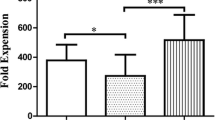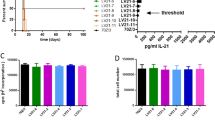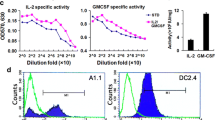Summary
The capacity of the interferon inducer ABPP and recombinant interleukin-2 (IL-2) to generate lymphokine activated killer (LAK) cell activity in vivo was examined and compared to the cytolysis of fresh tumor cells by in vitro generated LAK cells. Various tumors differing in histology and immunogenicity were used in in vitro and in vivo experiments. The i.p. administration of ABPP or IL-2 generated much higher levels of LAK cell activity in the peritoneal exudate than in the spleen. Administration of 2 injections of ABPP was as effective as a 3-day course of moderate doses of IL-2. Generation of LAK cell activity by IL-2 was dose dependent. ABPP had significant antitumor activity in vivo in both the i.p. tumor model and the pulmonary metastasis model when administered early (24–48 h after tumor inoculation), but was ineffective against established (day 3) tumor or advanced grossly visible i.p. (day 8) tumor. Treatment of established tumor with IL-2 and LAK cells was not more effective when ABPP was given concurrently. In contrast when ABPP preceded IL-2 and LAK treatment an additional antitumor effect was seen. Immunogenic tumors were more sensitive to treatment with ABPP than nonimmunogenic tumors. Only a marginal difference in lysability in vitro existed. The antitumor effects of ABPP in vivo may therefore be mediated by mechanisms other than cytolysis by activated killer cells alone. These data taken together suggest that ABPP and IL-2 induce discernable levels of LAK cell activity, but do not synergize when combined
Similar content being viewed by others
References
Brideau RJ, Wolcott JA (1985) Effect of pyrimidinone treatment on lethal and immunosuppressive murine cytomegalovirus infection. Antimicrob Agents Chemother 28:485–488
Brunda M, Tarnowski D, Davatelis V (1986) Interaction of recombinant interferons with recombinant interleukin-2: differential effects on natural killer cell activity and interleukin-2 activated killer cells. Int J Cancer 37:787–793
Chang AE, Hyatt CL, Rosenberg SA (1984) Systemic administration of recombinant IL-2 in mice. J Biol Response Modif 3:561–573
Donahue JH, Rosenberg SA (1983) The fate of interleukin-2 after in vivo administration. J Immunol 130:2203–2208
Eggermont AMM, Marquet RL, De Bruin RWF, Jeekel J (1986) Effects of interferon-inducer ABPP on colon cancer in rats; importance of tumor load and tumor site. Cancer Immunol Immunother 22:227–230
Eggermont AMM, Marquet RL, De Bruin RWF, Weimar W, Jeekel J (1986) Site-specific antitumor effects of 2 pyrimidinone compounds in rats. Br J Cancer 54:337–339
Eggermont AMM, Marquet RL, De Bruin RWF, Jeekel J (1986) Efficacy of treatment with ABPP and recombinant gamma interferon on colon cancer in rats depends on tumor site tumor load and treatment schedule. Surg Forum 37:342–344
Eggermont AMM, Steller EP, Ottow RT, Matthews W, Sugarbaker PG (1987) Augmentation of interleukin-2 immunotherapeutic effects by lymphokine activated killer cells and allogeneic stimulation in murine tumor models. J Natl Cancer Inst (in press)
Eggermont AMM, Sugarbaker PH, Marquet RL, Jeekel J (1987) Synergistic antitumor activity of cyclophosphamide and ABPP in the treatment of established and advanced tumors in murine tumor models. Cancer Immunol Immunother 25:16–24
Ettinghausen Se, Lipford EH, Mule JJ, Rosenberg SA (1985) Recombinant interleukin-2 stimulates in vivo lymphoid cell proliferation in tissues. J Immunol 135:1488–1493
Fast PE, Hatfield CA, Sun EL, Stringfellow DA (1982) Polyclonal b-cell activation and stimulation of specific antibody responses by 5-halo pyrimidinones wiith antiviral and antineoplastic antivity. J Biol Response Medif 1:199–215
Grimm EA, Robb RJ, Roth JA, Neckers LM, Lachman LB, Wilson DJ, Rosenberg SA (1983) Lymphokine activated killer cell (LAK) phenomenon: III. Evidence that IL-2 alone is sufficient for diirect activation of PBL into LAK. J Exp Med 158:1356–1366
Hamilton RD, Wynalda MA, Fitzpatrick DL, Teagarden AH, Hamdy AH, Snider BG, Weed SD, Stringfellow DA (1982) Comparison between circulating interferon and drug levels following administration of 2-amino-5-bromo-6-phenyl-4(3H)-pyrimidinone (ABPP) in different animal species. J Interferon Res 2:317–327
Kasahara T, Djeu JY, Dougherty SF, Oppenheim JJ (1983) Capacity of human large granular lymphocytes (LGL) to produce multiple lymphokines: Interleukin 2, interferon, and colony stimulating factor. J Immunol 131:2379–2380
Lafreniere R, Rosenberg SA (1985) Successful immunotherapy of experimental hepatic metastases with lymphokine activated killer cells and recombinant interleukin-2. Cancer Res 45:3735–3741
Li LH, Wallace TL, Richard KA, Tracey DE (1985) Mechanism of antitumor action of pyrimidinones in the treatment of B16 melanoma and P388 leukemia. Cancer Res 45:532–538
Lotzova E, Savary CA, Stringfellow DA (1983) 5-halo-6-phenyl-pyrimidinones: new molecules with cancer therapeutic potential and interferon-inducing capacity are strong inducers of murine natural killer cells. J Immunol 130:965–969
Milas L, Hersch EM, Stringfellow DA, Hunter N (1982) Studies on the antitumor activities of pyrimidinone-interferon inducers. I. Effect against artificial and spontaneous lung metastases of murine tumors. J Natl Cancer Inst 68:139–145
Mule JJ, Shu S, Schwarz SL, Rosenberg SA (1984) Adoptive immunotherapy of established pulmonary melanoma metastases by the intravenous adoptive transfer of syngeneic lymphocytes activated in vitro by interleukin-2. Science 225:1487–1492
Oku T, Imanishi J, Kishida T (1984) Interferon counteracts pyrimidinone induced hyporeactivity and the combined treatment has antitumor effect in mice. Gann 75:631–640
Ottow RT, Steller EP, Sugarbaker PH, Wesley RA, Rosenberg SA (1987) Immunotherapy of intraperitoneal cancer with interleukin-2 and lymphokine activated killer cells: Reduction of tumor and survival benefits in the murine models. Cell Immunol 104:366–376
Ottow RT, Eggermont AMM, Steller EP, Matthews W, Sugarbaker PH (1987) Requirements for successful immunotherapy of intraperitoneal cancer uring interleukin-2 and lymphokine activated killer cells. Cancer 60:1465–1473
Papa MZ, Mule JJ, Rosenberg SA (1986) The anti-tumor efficacy of lymphokine-activated killer cells and recombinant interleukin-2 in vivo: Successful immunotherapy of established pulmonary metastases from weakly and nonimmunogenic murine tumors of three distinct histologic types. Cancer Res 46:4973–4978
Parker GA, Rosenberg SA (1977) Serologic identification of multiple tumor associated antigens on murine sarcomas. J Natl Cancer Inst 58:1303–1309
Rosenberg SA, Grimm EA, McGrogan M, Doyle M, Kawasaki E, Koths K, Mark DF (1984) Biological activity of recombinant human interleukin-2 produced in Escherichia coli. Science 223:1412–1415
Rosenberg SA, Mule JJ, Spiess PJ, Reichert CM, Schwarz SL (1985) Regression of established pulmonary metastases and subcutaneous tumor mediated by the systemic administration of high-dose recombinant interleukin 2. J Exp Med 161:1169–1188
Rosenberg SA, Lotze MT, Muul LM, Leitman S, Chang AE, Ettinghausen SE, Matory YL, Skibber JM, Shiloni E, Vetto JT, Seipp CA, Simpson C, Reichert CM (1985) Observations on the systemic administration of autologous lymphokine-activated killer cells and recombinant interleukin-2 to patients with metastatic cancer. J Engl J Med 313:1485–1492
Rosenstein M, Yron I, Kaufmann Y, Rosenberg SA (1984) Lymphokine-activated killer cell: lysis of fresh syngeneic natural killer-resistant murine tumor cells by lymphocytes cultured in interleukin-2. Cancer Res 44:1946–1953
Saito T, Ruffmann R, Welker RD, Herberman RB, Chirigos MA (1985) Development of hyporesponsiveness of activity after multiple treatments with biological response modifiers. Cancer Immunol Immunother 19:130–135
Stringfellow DA (1981) 6-Aryl pyrimidinoles: interferon inducers — antiviral and antineoplastic agents. In: Hersch EM, Chirigos MA, Mastrangelo MJ (eds) Augmenting agents in cancer therapy. Raven Press, New York, pp 215–228
Author information
Authors and Affiliations
Rights and permissions
About this article
Cite this article
Eggermont, A.M.M., Sugarbaker, P.H., Marquet, R.L. et al. In vivo generation of lymphokine activated killer cell activity by ABPP and interleukin-2 and their antitumor effects against immunogenic and nonimmunogenic tumors in murine tumor models. Cancer Immunol Immunother 26, 23–30 (1988). https://doi.org/10.1007/BF00199843
Received:
Accepted:
Issue Date:
DOI: https://doi.org/10.1007/BF00199843




